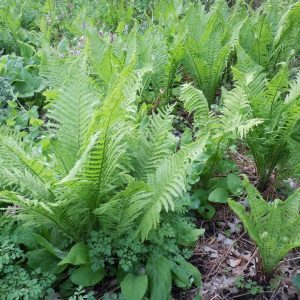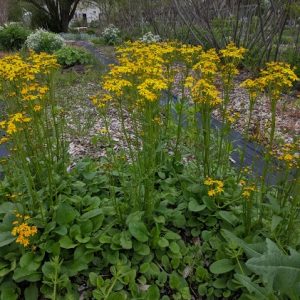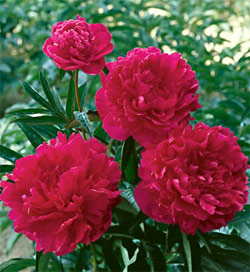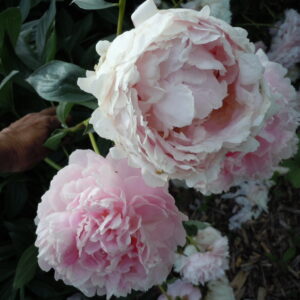Shop
Showing 529–536 of 788 results
-
Osmunda cinnamomea Cinnamon fern Z 4-8
The species name refers to its cinnamon-brown spore bearing stalks.
OUT OF STOCK
The species name refers to its cinnamon-brown spore bearing stalks.
Size: 36” x 24”
Care: Part shade in moist soil
Native: Eastern No. America
Awards: Royal Horticultural Society Award of Merit.The species name refers to its cinnamon-brown spore bearing stalks. Cherokee used this fern to cure snakebites by applying the chewed root to the bite. Roots cured rheumatism and chills. Cooked spring fronds made a tonic. 1st collected by Rev. John Banister in colonial Virginia c. 1680. A gunman mistakenly shot and killed him while he collected plants. Its fiddleheads are food for ruffed grouse, and hummingbirds sometimes use the fuzz on young fronds to line their nests.
-
Osmunda regalis Royal fern Z. 4-10
Lance-shaped double divided leaves. Late summer erect brown tassels form – they are fertile fronds. One of internationally known garden designer Piet Oudolf’s 100 “MUST HAVE” plants, Gardens Illustrated 94 (2013)
OUT OF STOCK
Lance-shaped double divided leaves. Late summer erect brown tassels form – they are fertile fronds. One of internationally known garden designer Piet Oudolf’s 100 “MUST HAVE” plants, Gardens Illustrated 94 (2013)
Size: 4-6’ x 12’
Care: Sun to Light shade, moist, humusy, acidic, fertile soil
Native: Eastern North America
Awards: Great Plant Pick Award from Elisabeth Carey Miller Botanical Garden & England’s Royal Horticultural Society Award of Merit.Osmunda named for Osmunder, a Saxon god. Winnebago used the root medicinally and the leaves as a bed when hunting. 1st collected by Rev. John Banister who moved to colonial Virginia in 1678. A gunman mistakenly shot and killed him while he collected plants.
-
Packera obovata syn. Senecio obovata Round-leaved ragwort, Golden groundsel Z. 3-8
Clusters of perky yellow daisies with sunny centers atop nearly leafless, erect stems, blooming late spring to early summer. Missouri Botanic Garden: “Vigorous spring wildflower for sunny or shady areas of the landscape. Large, naturalized plantings in woodland gardens can be spectacular in bloom. Cut off flowering stems after bloom and enjoy the semi-evergreen basal foliage which forms an attractive ground cover.”
Clusters of perky yellow daisies with sunny centers atop nearly leafless, erect stems, blooming late spring to early summer. Missouri Botanic Garden: “Vigorous spring wildflower for sunny or shady areas of the landscape. Large, naturalized plantings in woodland gardens can be spectacular in bloom. Cut off flowering stems after bloom and enjoy the semi-evergreen basal foliage which forms an attractive ground cover.”
Size: 1-2’ x 6-12” spreading
Care: sun to part shade in moist to moist well-drained soil
Native: curved swath from eastern Canada to FL west to IL and NM
Wildlife Value: attracts bees. Deer resistantObovata means egg-shaped describing the shape of its basal leaves. First named in 1803 from a plant of Rev. Henry Muhlenberg (1783-1815) (https://en.wikipedia.org/wiki/Gotthilf_Heinrich_Ernst_Muhlenberg,) Pennsylvania plantsman, sent to German botanist Carl Ludwig Willdenow (1765 – 1812). Packera named for a Canadian botanist, John G. Packer.
-
Paeonia ‘Seashell’ Sea Shell peony Z 3-8
Blousy, single, ballerina pink petals 6” across, surround golden centers in mid-season, sweetly fragrant.
Blousy, single, ballerina pink petals 6″ across, surround golden centers in mid-season, sweetly fragrant.
Size: 36"x 36"
Care: sun to part sun in moist well-drained soil. Plant “eyes” no deeper than 2” below soil. If planted too low, it will not flower.
Wildlife Value: Deer resistant.
Awards: American Peony Society Gold Medal in 1990.Paeonia is derived from the Greek mythical figure Paeon, who Pluto turned into a flower. Theophrastus described the peony around 300 B.C. Dioscorides, 1st century A.D., claimed the root eased the pain of childbirth. During the Middle Ages peonies used in Europe to remedy the falling sickness, cleaning women after child birth, nightmares, and melancholy. The “surest way” to effect a cure was to hang fresh root around the neck. Otherwise an infusion should be taken before and after a full moon. ‘Seashell’ introduced by H.F. Sass in 1937.
-
Paeonia ‘Butterbowl’ Peony Z 2-8
Pale pink single petals surround blousy yellow central petals, hence ‘Butterbowl.’
Pale pink single petals surround blousy yellow central petals, hence ‘Butterbowl.’ Fragrant too. Blooms midseason.
Size: 36” x 24-30”
Care: sun to part sun in fertile, moist well-drained soil. Plant “eyes” no deeper than 2” below soil. If planted too low, it will not flower.Paeonia is derived from the Greek mythical figure Paeon, physician to Pluto who cured Pluto after his defeat by Hercules. In thanks Pluto turned Paeon into a flower. Peonies have been in gardens since Greek and Roman times. ‘Butterbowl’ bred and introduced by Rosenfield, 1955.
-
Paeonia ‘Felix Crousse’ Z 3-8
Fragrant dark pink double blooms in mid-spring
Fragrant dark pink double blooms in mid-spring
Size: 28 x 28
Care: Full sun in moist, well-drained soil, protect from strong winds
Awards: Received England’s Royal Horticultural Society Award of Merit.Paeonia is derived from the Greek mythical figure Paeon, physician to Pluto who cured Pluto after his defeat by Hercules. In thanks Pluto turned Paeon into a flower. Peonies have been in cultivation since Greek and Roman times. Theophrastus, a student of Socrates, described the peony around 300 B.C.. Dioscorides, writing in the 1st century A.D., claimed the root eased the pain of childbirth. During the Middle Ages peony was used in Europe both for food and medicine. Sent from the European continent to England in 1548. Nicholas Culpepper, in The Complete Herbal & English Physician, lists ailments which various peony parts remedied: the falling sickness, cleaning women after child birth, nightmares, and melancholy. The “surest way” to effect a cure was to hang fresh root around the neck. Otherwise an infusion should be taken before and after a full moon
-
Paeonia ‘Karl Rosenfield’ Peony Z 3-8
Double deep carmine blossoms in mid-season
Double deep carmine blossoms in mid-season
Size: 28-32” x 28-32”
Care: Full sun to part shade moist well-drained soil, protect from strong windPaeonia is derived from the Greek mythical figure Paeon, physician to Pluto who cured Pluto after his defeat by Hercules. In thanks Pluto turned Paeon into a flower. Peonies in cultivation since Greek and Roman times. Theophrastus, a student of Socrates, described the peony around 300 B.C.. Dioscorides, writing in the 1st century A.D., claimed the root eased the pain of childbirth. During the Middle Ages peony was used in Europe both for food and medicine. Nicholas Culpepper, in The Complete Herbal & English Physician, lists ailments that various peony parts remedied: the falling sickness, cleaning women after child birth, nightmares, and melancholy. The “surest way” to effect a cure was to hang fresh root around the neck. Otherwise an infusion should be taken before and after a full moon. P. ‘’Karl Rosenfield’ introduced by Rosenfield in 1908.
-
Paeonia ‘Sarah Bernhardt’ Peony Z 3-8
Huge, frilly pastel pink blossoms late in the season, fragrant
Huge, frilly pastel pink blossoms late in the season, fragrant
Size: 36” x 36”
Care: sun to part shade in moist well-drained soil. Plant "eyes no deeper than 1-2" below soil level
Awards: Royal Horticultural Society Award of Merit.Paeonia is from Greek mythical figure Paeon, physician to Pluto who cured Pluto after his defeat by Hercules. In thanks Pluto turned Paeon into a flower. Peonies in gardens since ancient Greece. P. ‘Sarah Bernhardt’ introduced by French nursery Lemoine in 1906.







